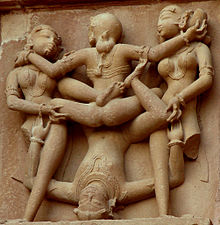Mithuna



As Mithunas or Maithunas ( Sanskrit : मैथुन = “union”, “couple”, “wedding”, “sexual intercourse”) are called “heavenly lovers” in Indian art , which are at Buddhist , Jainist or Hindu (cave) temples or Toranas are attached. Mithuna sculptures are spread all over India; however, they are more common in northern India than in the south of the country.
history
Since the 2nd century BC There are depictions of loving couples standing or sitting next to each other (sometimes also riding elephants or bulls or buffalos) as reliefs or on pillars or pillars of the Buddhist stupas or cave temples (e.g. Bharhut , Amaravati , Bedsa , Karli et al.). A little later they appear, embraced tenderly on portal facades (e.g. Karli). Jainism and Hinduism took over both the motif and the type of representation, which in the following centuries developed into clearly erotic representations , especially at Hindu temples (e.g. Kalika Mata temples in Chittorgarh , Lakshmana , Vishvanatha and Kandariya -Mahadeva Temple in Khajuraho , Sas Bahu Temple in Nagda and many others).
In the course of the Islamic conquest of North India, a large number of erotic and other sculptures were destroyed; new temples were hardly built after that. Only during the Mughal rule did the situation relax a little - painters and draftsmen produced a wealth of erotic miniatures for the court, which lacked any religious and philosophical level.
art
painting
Although it has rarely survived, it can be assumed that many painted Mithunas also existed. The best preserved can be found in Ajanta (Cave XVII), although it should be noted that these early paintings lack any erotic component - instead, there is a loving sitting together.
sculpture
The erotic figures of India develop - like all Indian sculpture - from early relief-like to the almost fully plastic sculptures of the heyday. Whether the form of representation, which is more realistic from a formal point of view, can also be transferred to the content is a much discussed but not conclusively clarified question.
interpretation
The Mithunas can essentially be interpreted on three levels:
Love and religion
In many cultures and cultural practices, the spheres of (God's) love , ecstasy , trance , sexuality and religion are close together; In a state of intoxication, sexual and religious feelings can be increased equally. But only in India has this thinking or feeling found a broad artistic expression (cf. also Kamasutra , Tantra , Bhakti ).
Mithuna ritual
Maithuna ritual means sexual union in a ritual context (spiritual or sacred sexuality). A Maithuna ritual was celebrated in India in the tantric schools of the Kaulas (a Shivaite school of Hindu tantra) and Shaktas (a school of Hindu tantra that emphasize and worship Shakti ) and took place in the group.
Union of opposites
Another complex of topics addressed in the Mithunas is the search for the (re-) unification of opposing principles such as that of man and woman. Through their union, a state of supernatural harmony can and should be achieved in which all - supposed or actual - opposites are abolished. The Mithunas can thus be understood as a pictorial realization of this thought or as an invitation or suggestion to imitate it.
Defense against evil
Most Mithuna pairs are attached to the portal walls or to the outer walls of the temples; They are rarely found inside the temple buildings. This placement makes a disastrous ( apotropaic ) function of these figures likely - in the presence of love and eroticism, ominous, i.e. H. demonic or destructive forces no longer have room to develop.
See also
literature
- Bernard Soulié: Erotic Art of India. Gondrom, Bayreuth 1982, ISBN 3-8112-0300-2 .
- Kamala Devi: The Eastern Way of Love. Simon & Schuster, 1985, ISBN 0-671-60432-5 .
- Omar V. Garrison: Tantra: the Yoga of Sex. Harmony Books, New York, 1983, ISBN 0-517-54948-4 .
- Prithvi Kumar Agrawala: Mithuna. The Male-Female Symbol in Indian Art and Thought. Munshiram Manoharlal Publishers, New Delhi 1983, ISBN 81-215-0142-3 .
- VV Sudha Piratti: Mithuna in Buddhist art - with special reference to Amaravati & Nagarjunakonda. Bharatiya Kala Prakashan, 2002, ISBN 81-86050-88-4 .
Web links
References and comments
- ^ Gavin Frost, Yvonne Frost: T antric Yoga: The Royal Path to Raising Kundalini Power. Motilal Banarsidass Publ., 1996, ISBN 978-8-1208-1231-4 , pp. 125–126 ( [1] on books.google.de)





